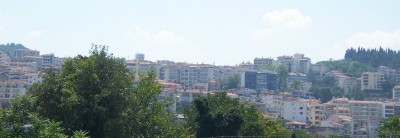|
The content on this website is
maintained by Robert
Myallis, pastor at Zion's
Lutheran Church, of Jonestown, PA.
The photos were taken by Emily
Myallis, a diaconal minister in the ELCA who also serves at
Zion's Lutheran.
This website and travel to
Greece was made possible by a grant from the
Fund for Theological Education,
which provides grants to assist the education and formation of
Christian leaders from numerous denominations.
Bible quotes are taken from the New
Revised Standard Version, unless cites otherwise.
The above photo of Greece comes from
NASA; The icon of Saint Paul comes from George Mitrevski's website. |
 |
|
Berea
 Nestled
into the hillside, the town of Beroea lies about 45 miles west of Thessaloniki. Nestled
into the hillside, the town of Beroea lies about 45 miles west of Thessaloniki.
How is Berea significant for
understanding the world of Paul?
Beroea would not have been a convenient place to go by foot at night from
Thessaloniki. Yet feeling from persecution, this is precisely where Paul and his
companion Silas go, suggesting the urgency of the situation.
That very night the believers sent Paul and Silas off to Beroea; and when
they arrived, they went to the Jewish synagogue. These Jews were more
receptive than those in Thessalonica, for they welcomed the message very eagerly
and examined the scriptures every day to see whether these things were so. Many
of them therefore believed, including not a few Greek women and men of high
standing. But when the Jews of Thessalonica learned that the word of God
had been proclaimed by Paul in Beroea as well, they came there too, to stir up
and incite the crowds. Then the believers1 immediately sent Paul away to the
coast, but Silas and Timothy remained behind. Those who conducted Paul brought
him as far as Athens; and after receiving instructions to have Silas and Timothy
join him as soon as possible, they left him. (Acts, chapter 17:10-15)
|
|



 Nestled
into the hillside, the town of Beroea lies about 45 miles west of Thessaloniki.
Nestled
into the hillside, the town of Beroea lies about 45 miles west of Thessaloniki.